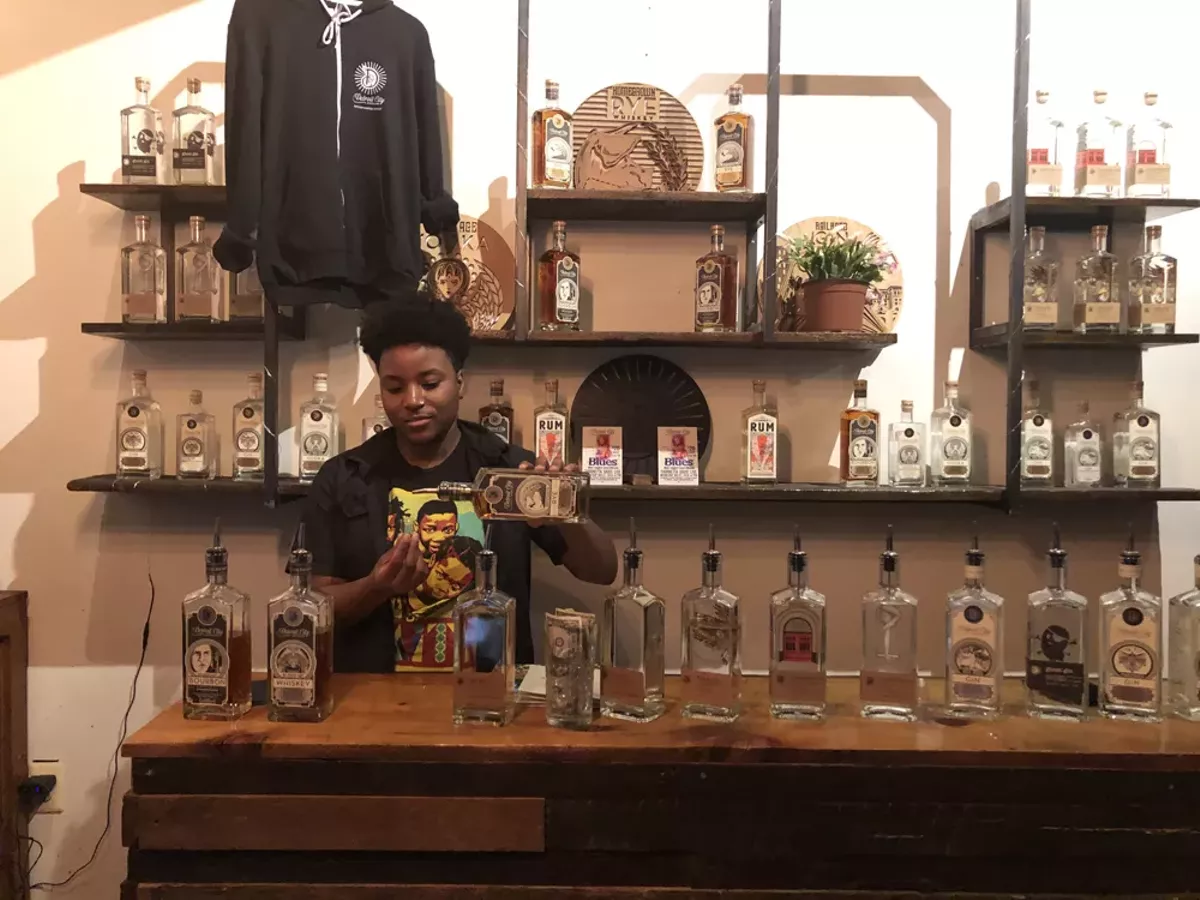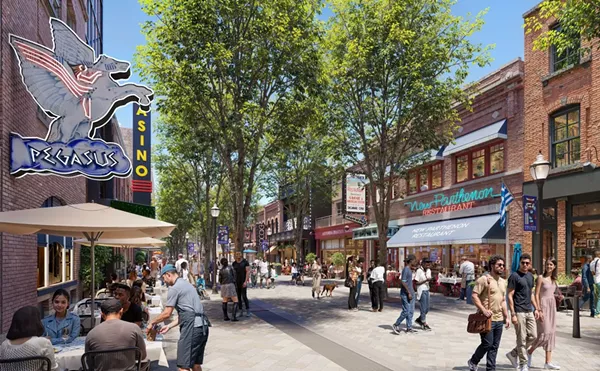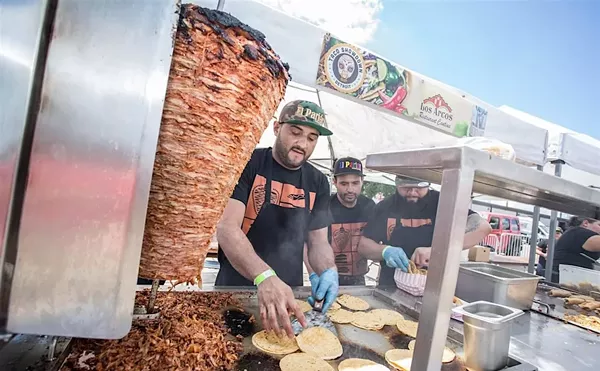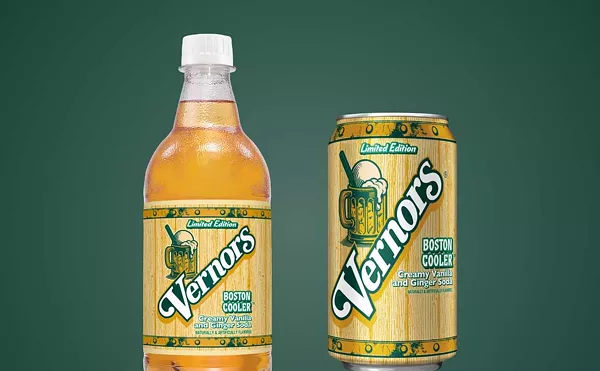

Audio By Carbonatix
[
{
"name": "GPT - Leaderboard - Inline - Content",
"component": "35519556",
"insertPoint": "5th",
"startingPoint": "3",
"requiredCountToDisplay": "3",
"maxInsertions": 100,
"adList": [
{
"adPreset": "LeaderboardInline"
}
]
}
]
Making moonshine may seem romantic, but the reality is a much more harsh story, filled with crime and heartbreak. Detroit's long love story with whiskey has both shaped and reflected the greater American relationship with whiskey.
Before the Scots came, it was mostly brandy. In fact, Detroit's European settlement is thanks in part to Antoine Cadillac's insistence that the land would be the perfect location for vineyards rivaling the greatest Burgundian producers. Just a few years after making these claims, Cadillac was exiled from the settlement, and found guilty of smuggling, extortion, and illegal alcohol sales. Brandy was king in Detroit for many years; it was valuable in the world market, potent, and it aged well on the long journey into the interior. Once the British took over, they brought with them a taste for whiskey, as well as a similar penchant for avoiding taxes and excises.
By the 1830s, Scottish and especially Irish settlers were arriving in numbers, bringing a taste for the peated and pot-stilled whiskies of their home countries. The completion of the Erie Canal in 1825 opened the Great Lakes to the cities of the eastern seaboard. In 1838, a 22-year-old arrived in Detroit from Douglas, Massachusetts. Young Hiram Walker tried — and failed — at several careers in the bustling frontier town until he finally made a go of it as a grocer with a store at the foot of Woodward Avenue, right along the riverside docks that brought in his imported sugar, cheese, coffee, and tea. Pretty soon he developed a knack for distilling vinegar for his customers. It was a short jump from there to distilling whiskey, a far more profitable venture.
Walker started selling his Club Whisky as early as 1850. When an 1855 Michigan state law forbade anyone but chemists from producing whiskey in the state, though, he moved operations across the river to a strip of land on the Windsor side. He had good timing; since most American whiskies were distilled and barrelled in Southern states, the onset of the Civil War disrupted distilling, storing, and shipping all over the U.S. It was far easier to row a mile across the river than it was to navigate the war-torn Southern countryside in search of quality booze.
Walkerville (as it was officially named in 1869) was a company town through and through. And Hiram loomed over all. In the words of a contemporary, Walker was "a unique municipal figure, being practically the mayor, common council, board of public works, fire department, lighting and water works manager." By 1882, Walkerville held over 600 full-time residents, a church, and a school. One person who never became a Walkerville resident was Walker himself. He chose instead to build a mansion in Detroit and traveled daily by private ferry to his distillery.
In 1865, Hiram Walker was the first distiller to put whiskey into individually sealed and labeled bottles. Of his plan, he wrote, "we will make a fine whisky and we do not wish it to be confused with inferior products. We will also brand each barrel, so that discriminating patrons can trust its quality."
Always a genius at marketing, Walker capitalized on his brand to tout quality and recognition. Frustrated, several American distillers convinced the government to require that all products sold in the States bear their country of origin prominently. Thus, in 1880, Club Whisky became Canadian Club Whisky. Far from sullying Walker's whiskey's image, the new label added a foreign flair to the product, and Walker's success compounded. By 1893, Walker dominated the global whiskey market.
Both Walker's reputation for quality and his ferry came in handy just a few years later, once Prohibition went into effect. In 1929, 500 to 600 cars per hour were crossing from Detroit to Walkerville. With such proximity to Canada and its distilleries, Detroit was the epicenter of Midwestern bootlegging. And, as the first major American city to go Dry in 1918, Detroit was also the test case for American Prohibition efforts.
By many accounts, Detroiters failed that test. In 1919 American Magazine reported, "When a man can buy for five dollars a still with which he can make whiskey, it is going to be very hard to stop the manufacture entirely." In fact, Prohibition managed to turn some beer drinkers into whiskey tipplers. Since it was so expensive to produce and transport anything alcoholic, bootleggers concentrated on the higher-proof items like whiskey rather than wine or beer. A Congressional hearing in 1919 found "former beer drinkers have become whiskey drinkers" and "more whiskey is being drunk under prohibition in Detroit than was drunk under license." Detroit had twice as many arrests for drunkenness in its first full year of Prohibition (1919) as it had the previous year.
Prohibition, too, signaled the birth of many cocktails as we know them. Although cocktails and punch had been around a few decades by the turn of the 20th century, cocktail culture was born from the need to disguise the taste of rotgut whiskey and moonshine. Detroit had it marginally better than much of the Midwest, with its easy access to Canadian distilleries, railroad shipments, and quick transport by boat and automobile, even airplane. But it was still a great relief when Michigan became the first state to vote to Repeal in 1933.
As the first major American city to go Dry in 1918, Detroit was also the test case for American Prohibition efforts. By many accounts, Detroiters failed that test.
tweet this
Once the great national experiment of Prohibition ended, distillers wasted no time getting back to the stills in volume. Several distilleries opened their doors posthaste, including Mohawk Liquor in Novi and Arrow Liquors at Concord and Mack Avenue in Detroit, which opened (officially) in October of 1933. Arrow made a wide range of products during its heyday. It was the first distiller to mass-produce Peppermint Schnapps. It also caught the international spirit early on, being one of the first American producers and distributors of the newest fad of the 1950s, vodka.
Arrow expanded the tiny Concord Avenue plant six or seven times until finally moving production to Allen Park in 1964, at which time it had annual sales of more than $15 million, which translates to around $122 million in 2019 dollars. Arrow produced a vast line of brandies, cordials, and liqueurs. "But," reported the Detroit Free Press on the announcement of a 1965 merger with a Connecticut distributor, "its fastest growing beverages, in an unquestionably expanding market ... are the company's new bottled-in-bond [Scotch] and Canadian whiskies."
Expansion and amalgamation were the name of the game for mid-century whiskey makers. Distillers went industrial on both sides of the river. Don Livermore, Master Blender for Hiram Walker & Sons, explains, "Once Prohibition ended in 1933, it forced distilleries to become more science-oriented in their practices. They started to understand microbiology, cereal science, and barrels."
They also, like Hiram Walker had 100 years previously, found ways to circumvent federal excises and taxes. Arrow imported Scotch whiskey in barrels, then bottled it as McMaster's, the number one "scotch" whiskey in America. Even with such efforts, though, distilling was costly. In 1955 the federal levy on a gallon of whiskey was $10.50 — roughly $100 now. With such high rates, only the largest conglomerates survived. Arrow, Mohawk, and other small distilleries were eventually gobbled up by national and then international conglomerates.
In the early 2000s, partially inspired by the success of the craft beer movement, some hardy souls began venturing into small-batch distilling. The city's first tasting room, Corktown's Two James, debuted in 2013, followed by Detroit City Distillery in Eastern Market in 2014. Ferndale's Valentine Vodka, which opened in 2007, debuted its Woodward Whiskey (later renamed Hazen Pingree Bourbon) in 2013, as well. And in 2017, the cumbersomely named but vital Craft Beverage Modernization and Tax Reform Act provided a massive boost to craft distillers.
In 2016, the federal tax rate for a gallon of whiskey was $13.50 per gallon, nearly unchanged from 40 years ago. The Distilled Spirits, Wine and Beer Excise Tax Provision of the 2017 bill dropped that rate to $2.70 per gallon for distillers selling fewer than 100,000 gallons per year. Despite the short window, several craft distillers have taken advantage of the tax cut to open or expand tasting rooms and product lines in the area, including Traverse City and Motor City Gas. But that tax cut is only valid through December 2019 unless Congress votes to extend it.
JP Jerome, founder and distiller for Eastern Market's Detroit City Distillery, worries that if the extension doesn't pass, his company won't be able to continue its planned expansions to bottling, storage space, and distilling equipment. "Since predicting what the federal government is going to do is the same as predicting the weather in Michigan," he says, "we are preparing for the worst case." His federal payouts will quintuple if the Act doesn't pass, he says. "Don't even get me started on the tax that the state of Michigan has spirits producers paying. The state takes better than $10 on a $30 dollar bottle of vodka ... more than our own gross profit. We employ 25 Michiganders," he explains, and source Michigan-grown grain, Michigan-made barrels, corks, and labels. Add to that recent state mismanagement of distributor RNDC's disastrous shortages, and it starts to make sense why so few souls dare to go into distilling.
Across the river, Hiram Walker's Livermore is focused on finding the perfect blended whiskey. "In the whiskey world," says Livermore, "it's all about market timing and consumer needs. The most important job of a Master Blender," he insists, "is talking to the consumer and understanding the wants and then being able to bring those needs into a blend. It's not about my taste profile."
He's seen a lot of interest lately in aging whiskey in different kinds of barrels, including Oloroso sherry and Carribbean rum.
DCD's Jerome and Hiram Walker's Livermore both hold PhDs in the sciences, Jerome in microbiology and Livermore in brewing and distilling. On both sides of the river, they and other metro Detroit distillers are combining the small heritage craft born of many generations with the cutting edge of science to continue the long legacy of Detroit whiskey makers. Let's just hope legislators and bureaucrats stay out of their way long enough for them to perfect their products.
You can sample dozens of whiskeys, Scotches, and bourbons at Metro Times' Whiskey in the Winter. Event begins at 7 p.m. (6:30 for VIP ticket holders) on Friday, Nov. 22 at the Detroit Shipping Co.; 474 Peterboro St., Detroit; 313-426-4973; mtwhiskeyinthewinter.com. Tickets are $35+.
Get our top picks for the best events in Detroit every Thursday morning. Sign up for our events newsletter.





